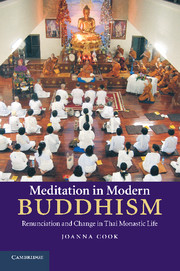Book contents
- Frontmatter
- Contents
- Acknowledgements
- List of map and figures
- Notes on language
- Map 1 Map of Thailand
- 1 Meditation and monasticism: making the ascetic self in Thailand
- 2 Meditation and religious reform
- 3 The monastic community: duty and structure
- 4 Meditation as ethical imperative
- 5 Language and meditation
- 6 Monastic duty, mindfulness and cognitive space
- 7 Money, mae chee and reciprocity
- 8 Hierarchy, gender and mindfulness
- 9 Monasticization and the ascetic interiority of non-self
- Appendix: Ordination transcript for an eight-precept nun (mae chee)
- Bibliography
- Index
1 - Meditation and monasticism: making the ascetic self in Thailand
Published online by Cambridge University Press: 03 May 2011
- Frontmatter
- Contents
- Acknowledgements
- List of map and figures
- Notes on language
- Map 1 Map of Thailand
- 1 Meditation and monasticism: making the ascetic self in Thailand
- 2 Meditation and religious reform
- 3 The monastic community: duty and structure
- 4 Meditation as ethical imperative
- 5 Language and meditation
- 6 Monastic duty, mindfulness and cognitive space
- 7 Money, mae chee and reciprocity
- 8 Hierarchy, gender and mindfulness
- 9 Monasticization and the ascetic interiority of non-self
- Appendix: Ordination transcript for an eight-precept nun (mae chee)
- Bibliography
- Index
Summary
Meditation practice has only become available to large numbers of Thai laity since the 1950s. In that time Buddhism in general and meditation specifically have been incorporated as representative markers in the presentation of Thailand as a modernizing nation state and a self-consciously ‘traditional’ kingship. The widespread adoption of meditation by the laity since the 1950s is identified by some scholars as the greatest single change to have come over Theravāda Buddhist countries since the Second World War (Gombrich and Obeyesekere 1988: 237). Today meditation is taught in monasteries throughout Thailand, Sri Lanka, Burma and, latterly, Nepal and is a widely popular and influential movement. Furthermore, the global interest in meditation practice is leading to its inclusion in varied syncretic and often secular practices. However, such inclusion is also feeding and informing the ways in which such practice is understood and propagated in the emblematic religious institutions of Buddhist monasteries.
I take the ethnographic study of a meditation monastery in northern Thailand, Wat Bonamron, as my window on the process of renunciation, forms of which are found in all major religions. This study analyses the impact and meaning of renunciatory moral practice from the perspective of the Buddhist renouncer. I consider monastic practitioners' experiences and understandings of themselves, the significance of renunciation, ascetic discipline, rituals and duties as well as the place of community in the renunciatory project and the historical development and changes in monasticism and meditation.
- Type
- Chapter
- Information
- Meditation in Modern BuddhismRenunciation and Change in Thai Monastic Life, pp. 1 - 25Publisher: Cambridge University PressPrint publication year: 2010



